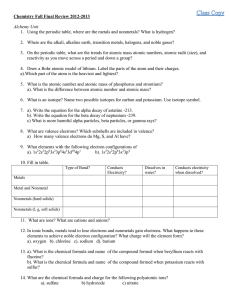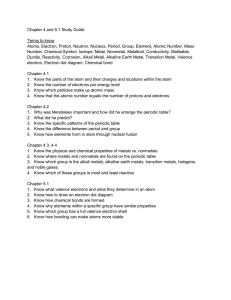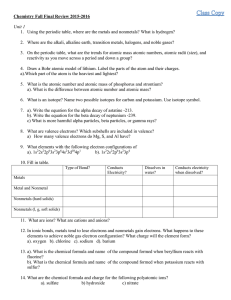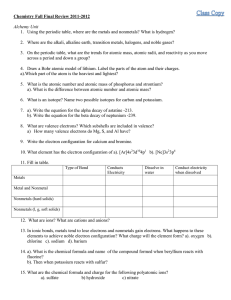Chemistry Fall Final Review Key Concepts:
advertisement
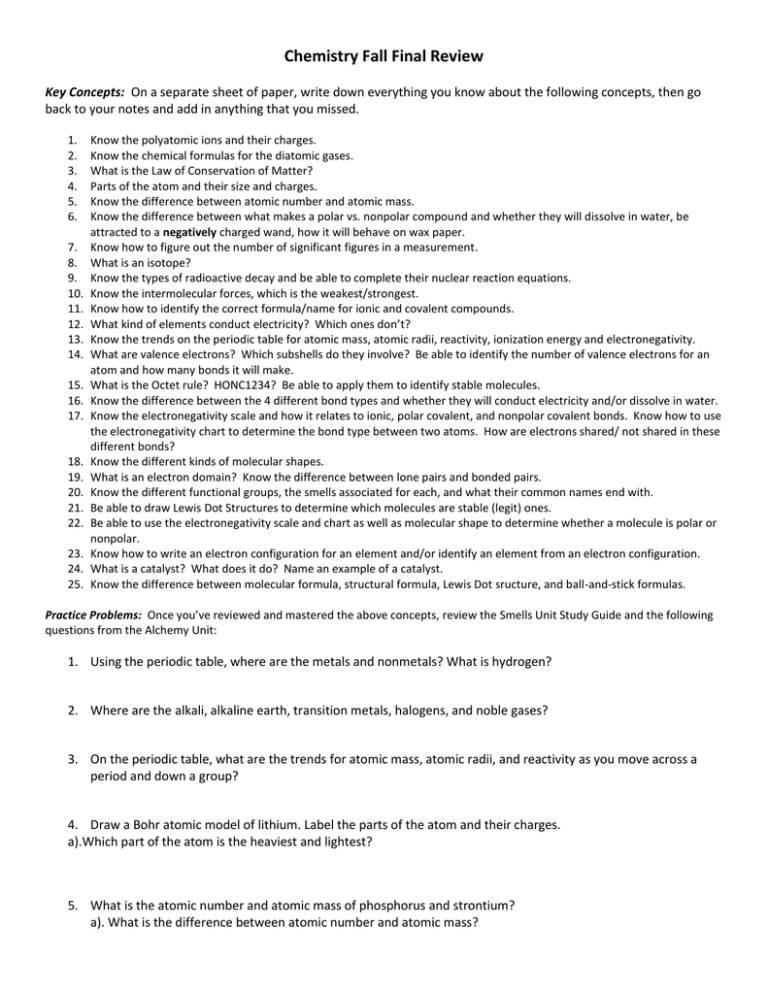
Chemistry Fall Final Review Key Concepts: On a separate sheet of paper, write down everything you know about the following concepts, then go back to your notes and add in anything that you missed. 1. 2. 3. 4. 5. 6. 7. 8. 9. 10. 11. 12. 13. 14. 15. 16. 17. 18. 19. 20. 21. 22. 23. 24. 25. Know the polyatomic ions and their charges. Know the chemical formulas for the diatomic gases. What is the Law of Conservation of Matter? Parts of the atom and their size and charges. Know the difference between atomic number and atomic mass. Know the difference between what makes a polar vs. nonpolar compound and whether they will dissolve in water, be attracted to a negatively charged wand, how it will behave on wax paper. Know how to figure out the number of significant figures in a measurement. What is an isotope? Know the types of radioactive decay and be able to complete their nuclear reaction equations. Know the intermolecular forces, which is the weakest/strongest. Know how to identify the correct formula/name for ionic and covalent compounds. What kind of elements conduct electricity? Which ones don’t? Know the trends on the periodic table for atomic mass, atomic radii, reactivity, ionization energy and electronegativity. What are valence electrons? Which subshells do they involve? Be able to identify the number of valence electrons for an atom and how many bonds it will make. What is the Octet rule? HONC1234? Be able to apply them to identify stable molecules. Know the difference between the 4 different bond types and whether they will conduct electricity and/or dissolve in water. Know the electronegativity scale and how it relates to ionic, polar covalent, and nonpolar covalent bonds. Know how to use the electronegativity chart to determine the bond type between two atoms. How are electrons shared/ not shared in these different bonds? Know the different kinds of molecular shapes. What is an electron domain? Know the difference between lone pairs and bonded pairs. Know the different functional groups, the smells associated for each, and what their common names end with. Be able to draw Lewis Dot Structures to determine which molecules are stable (legit) ones. Be able to use the electronegativity scale and chart as well as molecular shape to determine whether a molecule is polar or nonpolar. Know how to write an electron configuration for an element and/or identify an element from an electron configuration. What is a catalyst? What does it do? Name an example of a catalyst. Know the difference between molecular formula, structural formula, Lewis Dot sructure, and ball-and-stick formulas. Practice Problems: Once you’ve reviewed and mastered the above concepts, review the Smells Unit Study Guide and the following questions from the Alchemy Unit: 1. Using the periodic table, where are the metals and nonmetals? What is hydrogen? 2. Where are the alkali, alkaline earth, transition metals, halogens, and noble gases? 3. On the periodic table, what are the trends for atomic mass, atomic radii, and reactivity as you move across a period and down a group? 4. Draw a Bohr atomic model of lithium. Label the parts of the atom and their charges. a).Which part of the atom is the heaviest and lightest? 5. What is the atomic number and atomic mass of phosphorus and strontium? a). What is the difference between atomic number and atomic mass? 6. What is an isotope? Name two possible isotopes for carbon and potassium. 7. a). Write the equation for the alpha decay of astatine -213. b). Write the equation for the beta decay of neptunium -239. 8. What are valence electrons? Which subshells are included in valence? a) How many valence electrons do Mg, S, and Al have? 9. Write the electron configuration for calcium and bromine. 10. What element has the electron configuration of a). [Ar]4s23d104p1 b). [Ne]3s23p4 11. Fill in table. Type of Bond Conducts Electricity Dissolve in water Conduct electricity when dissolved Metals Metal and Nonmetal Nonmetals (hard solids) Nonmetals (l, g, soft solids) 12. What are ions? What are cations and anions? 13. In ionic bonds, metals tend to lose electrons and nonmetals gain electrons. What happens to these elements to achieve noble electron configuration? What charge will the element form? a). oxygen b). chlorine c). sodium d). barium 14. a). What is the chemical formula and name of the compound formed when beryllium reacts with fluorine? b). Then when potassium reacts with sulfur? 15. What are the chemical formula and charge for the following polyatomic ions? a). sulfate b) hydroxide c) nitrate

